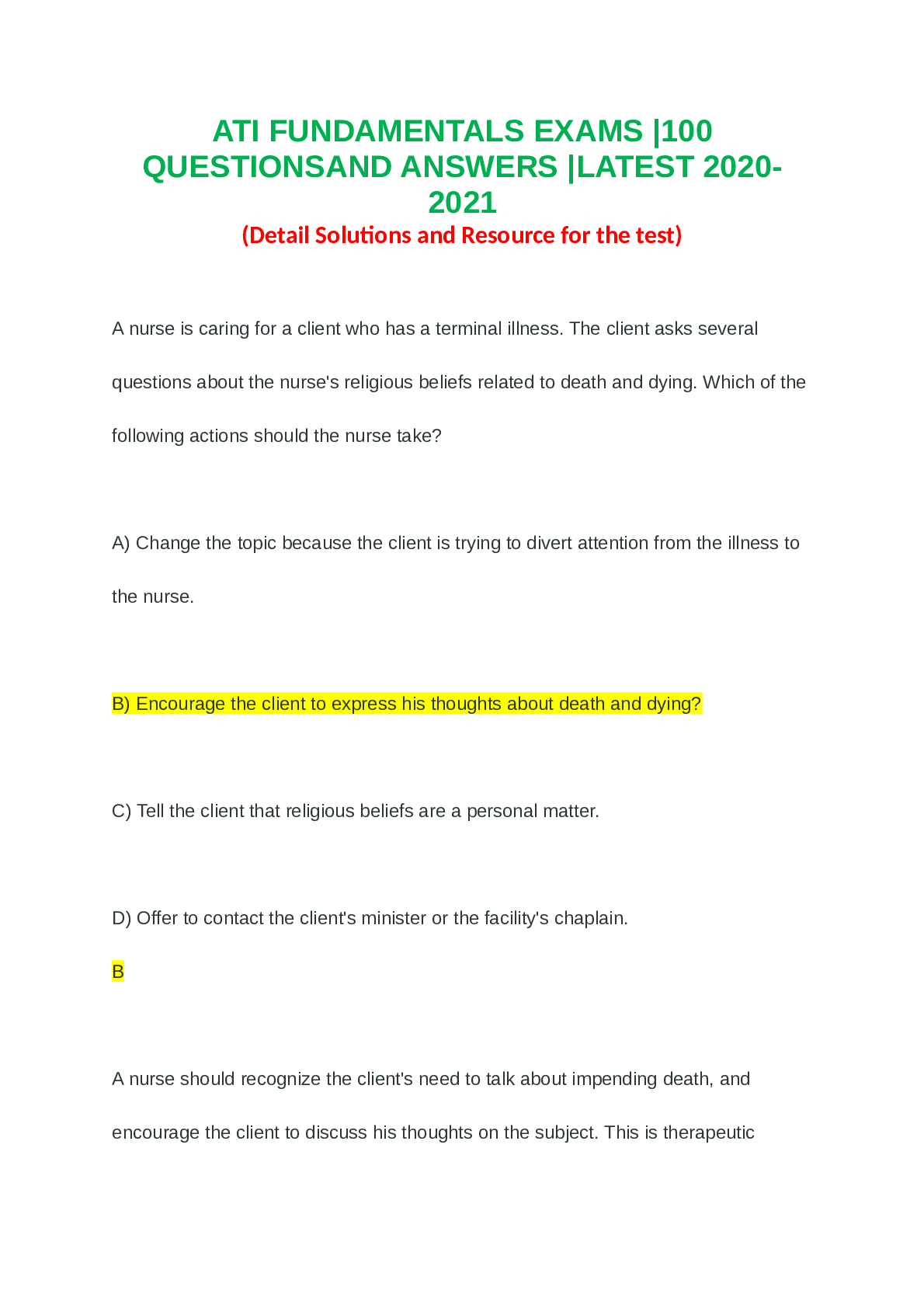*NURSING > QUESTIONS & ANSWERS > Cherry & Jacob: Contemporary Nursing: Issues, Trends, and Management, 7th Edition | Questions with C (All)
Cherry & Jacob: Contemporary Nursing: Issues, Trends, and Management, 7th Edition | Questions with Correct Answers | Graded A+ | Updated 2021
Document Content and Description Below
1. Clara Barton is known for: a. becoming the first black public health nurse. b. establishing the Henry Street Settlement. c. founding the American Red Cross. d. publicizing the inadequacies of h... ospital-based nursing schools. ANS: C The American Red Cross, founded by Clara Barton in 1882, assisted in efforts to continue public health nursing. DIF: Knowledge REF: p. 11 2. Students are assigned to write to their state leaders about an issue affecting their community. One student writes about the need among rural community for greater access to acute care services. Which of the following pieces of legislation should the student use as a reference? a. Social Security Act b. Hill-Burton Act c. Sheppard-Towner Act d. U.S. Civil Service Act ANS: B The purpose of the Hill-Burton Act was to provide funding to construct hospitals and to help states in plan for other health care facilities in accordance with the needs of communities. DIF: Knowledge REF: p. 13 3. The practice of public health nursing and the Henry Street Settlement are credited to: a. Mary Breckenridge. b. Mary Seacole. c. Clara Barton. d. Lillian Wald. ANS: D Lillian Wald, a pioneer in public health nursing, is best known for the development and establishment of the Henry Street Settlement. DIF: Knowledge REF: p. 6 4. Occupational health nursing features beliefs similar to those of which early nursing pioneer? a. Lillian Wald b. Florence Nightingale c. Clara Barton d. Mary Seacole ANS: A Lillian Wald developed the first nursing service for occupational health. DIF: Comprehension REF: p. 10 5. What historical event first led to the recognition of the contribution of blacks to nursing? a. Florence Nightingale’s acceptance of black nurses into the first nursing school b. The contributions of black nurses at the Pennsylvania Hospital, the first hospital in America c. Mary Seacole’s efforts to care for soldiers during the Crimean War d. The work done by wives of wealthy black nobles who carried food and medicine from house to house during the Middle Ages ANS: C Although Nightingale’s school refused Seacole, she was able to make a difference in the Crimean War and later was recognized for her efforts. DIF: Comprehension REF: pp. 8-9 6. World War I contributed to the advancement of health care by: a. increasing the number of private care hospitals and decreasing the role of public health services. b. employing a large number of civilians to provide care to returning soldiers through the Red Cross. c. introducing specialists in nursing such as nurse anesthetists. d. increasing the number of community health nurses. ANS: C World War I offered nurses a chance to enter into new fields of specialization, as is seen in the example of nurse anesthetists, who became part of surgical teams at the front lines. DIF: Comprehension REF: p. 11 7. The primary purpose of the Social Security Act of 1935 was to: a. increase research that focused on minority groups. b. provide medical care for chemically impaired persons. c. ensure health care for older adults through a national insurance system. d. decrease the public’s financial burden by limiting services offered by local health departments. ANS: C By providing health insurance for older adults, the Social Security Act of 1935 set the precedent for the passage of the Medicare and Medicaid Acts that followed in 1965, but the act also provided maternal and child welfare services, rehabilitation for the mentally and physically challenged, medical care for blind individuals and crippled children, and unemployment benefits. DIF: Comprehension REF: p. 12 8. A client asks the nurse, “Can you explain Medicare, an amendment to the Social Security Act?” The nurse responds that Medicare: a. led to many hospital closings, along with a decrease in acute care hospital–based nursing care. b. provided medical insurance to those younger adults or children who were not eligible for private insurance because of catastrophic illnesses such as cancer. c. provided preventive care for women, infants, and children. d. ensured that individuals ages 65 and older and those with end-stage renal disease or permanent disabilities had health care insurance. ANS: D The Medicare program provides hospital insurance, Part A, and medical insurance, Part B, to all people ages 65 and older who are eligible to receive Social Security benefits; people with total, permanent disabilities; and people with end-stage renal disease. DIF: Comprehension REF: p. 14 9. A comparison of nursing in the 1980s to nursing in the 1990s reveals that: a. in the 1990s nursing experienced a significant reduction occurred in preventable diseases caused by unsafe/unhealthy lifestyles. b. tuberculosis was the primary concern for nursing in the 1980s, whereas the AIDS epidemic emerged and was its focus during the 1990s. c. a decrease in ambulatory services in the 1980s prompted an increase in public health nurses in the 1990s. d. the demand for advanced practice nurses increased in the 1980s and the 1990s as a result of the economy and concern about the health of the nation. ANS: D The numbers of advanced nurse practitioners increased as evidence of their cost-effectiveness as providers of primary and preventive health care became established. DIF: Comprehension REF: pp. 16-17 10. Which statement accurately describes the historical perspective of nursing practice? a. Nursing has existed to meet the needs of populations, individuals, and aggregates by providing care that is determined by the needs and beliefs of society in different historical contexts. b. As men began to become interested in nursing, it changed into a respected profession based on scientific fact rather than superstition. c. Nursing has historically accepted individuals from all social and ethnic backgrounds. d. The United States has led the way throughout history to advance nursing and health care by providing the first hospital and medical school. ANS: A Nursing has existed since biblical times to address needs ranging from contagious diseases in early times to health prevention in the present time, with care based on health needs and beliefs of the time. DIF: Comprehension REF: p. 3 |pp. 18-19 11. The use of herbs has become a popular alternative to prescription drugs in today’s health care milieu. During which other historical periods did health practices focus on the use of herbs? a. Prehistoric times and the Middle Ages b. Civil War period and World War I c. Renaissance and Reformation periods and the Colonial American period d. Crimean War and Civil War periods ANS: A During prehistoric times, tribes used herbs to rid themselves of disease; in the Middle Ages, women used herbs. DIF: Comprehension REF: p. 6 12. A care provider sacrifices an animal and waves an herb-filled sack over a client who is complaining of painful joints and chest pain with exertion. This ritual represents health care during: a. the prehistoric period. b. early civilization in Egypt. c. the Renaissance. d. the Middle Ages. ANS: A During prehistoric times, illness was thought to be caused by evil spirits that providers attempted to scare away through rituals and dances. DIF: Comprehension REF: p. 3 13. A prospective nursing student who researches universities that offer a baccalaureate degree in nursing would want to ensure that the program is accredited by the: a. American Nurses Association. b. Commission on Collegiate Nursing Education. c. National Institutes of Health. d. National Nursing Council. ANS: B The Commission on Collegiate Nursing Education (CCNE) is the agency that exclusively accredits baccalaureate and graduate-degree nursing programs. DIF: Comprehension REF: p. 4, Box 1-1 14. Nursing in the 1990s was characterized by: a. men leaving nursing to enter the armed services. b. traditional 8-hour shifts to nurse burnout and compassion fatigue. c. a focus on preventable diseases. d. a decrease in nursing research. ANS: C Health promotion and disease prevention were recognized as the means to reduce the high number of mortalities associated with preventable diseases—Healthy People 2000 was published as a nationwide effort to reduce preventable deaths. DIF: Comprehension REF: pp. 16-17 15. A nurse is part of the policy committee for a hospital. The committee is provided with statistics indicating that patients participating in a satisfaction survey felt they lacked sufficient information about new drugs started while hospitalized and continued after discharge. In addition, charts noted high recidivism rates. The committee recommended that a formalized patient education plan be instituted to reconcile all medications and provide patient information about new medications. The committee is using which component of the Institute of Medicine (IOM) 2011 message? a. Nurses should achieve higher levels of education to be effective members of an interdisciplinary team. b. Nurses should have a minimum of a master’s degree to sit on policy committees that affect an entire facility. c. Pay for nurses should be consistent with that of physicians since the committee is interdisciplinary. d. Policy is based on data, which provides the groundwork for decision making. ANS: D The IOM report initiatives include effective workforce planning and policymaking based on better data collection and improved infrastructure. DIF: Application REF: p. 16| p. 18 16. The Affordable Care Act of 2011: a. requires that by 2020 all newly licensed nurses have a bachelor’s degree at minimum. b. would provide health care benefits to millions who were previously uninsurable or unable to afford insurance. c. caps the amount that hospitals and physicians can charge for procedures. d. subsidizes private insurance companies, thereby reducing health care costs for individuals who have chronic or catastrophic illness such as cancer. ANS: B It is anticipated that the ACA (2011) will make insurance coverage possible for millions who have previously not had insurance or had been denied insurance. DIF: Comprehension REF: pp. 18-19 17. It has been said that “history repeats itself because no one was listening the first time.” Which statement is true when comparing the nursing care provided in the Civil War (1861 to 1865) to that provided during the Crimean War? a. Epidemics such as smallpox and typhoid were the primary emphasis of nursing car [Show More]
Last updated: 1 year ago
Preview 1 out of 102 pages
Instant download

Buy this document to get the full access instantly
Instant Download Access after purchase
Add to cartInstant download
Reviews( 0 )
Document information
Connected school, study & course
About the document
Uploaded On
Oct 07, 2021
Number of pages
102
Written in
Additional information
This document has been written for:
Uploaded
Oct 07, 2021
Downloads
0
Views
37


.png)
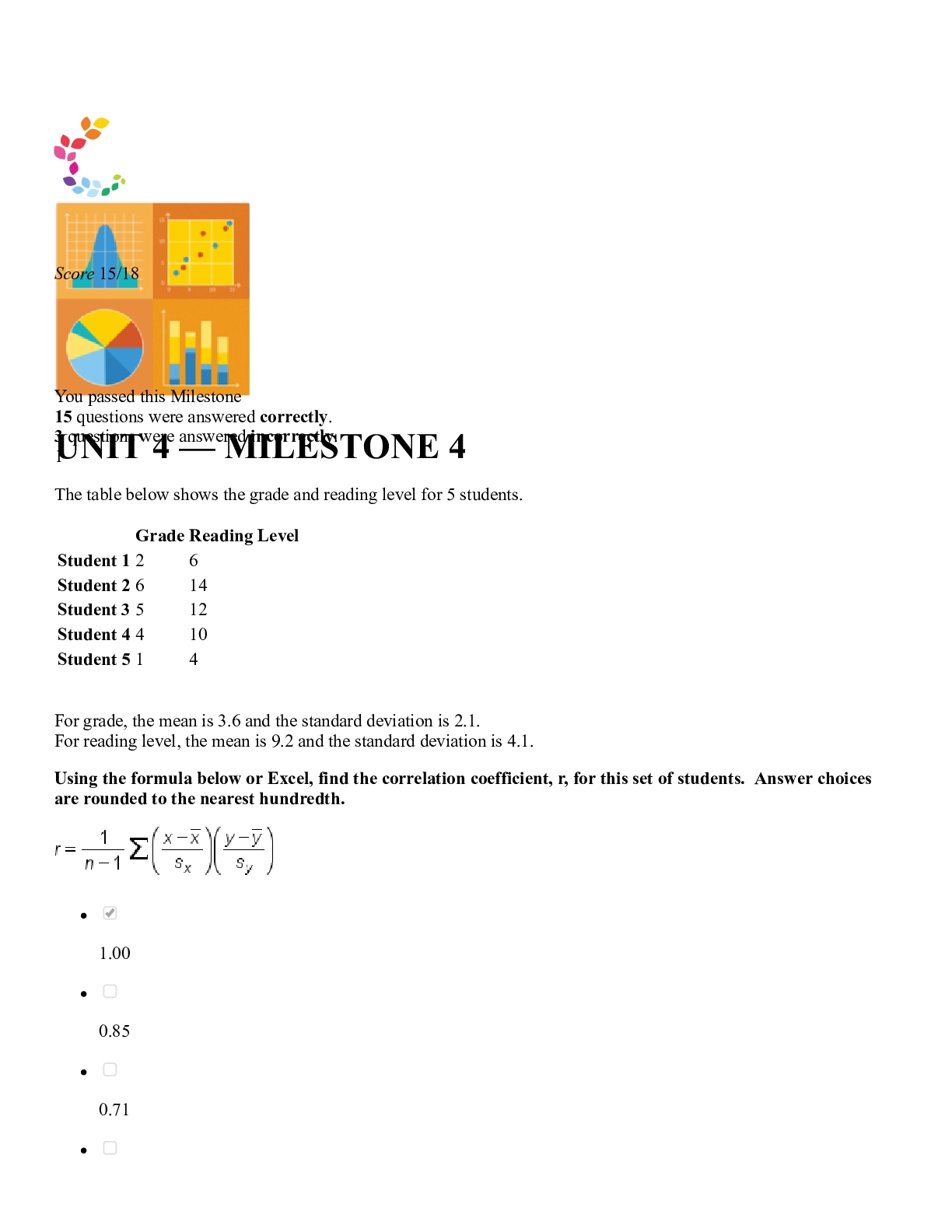

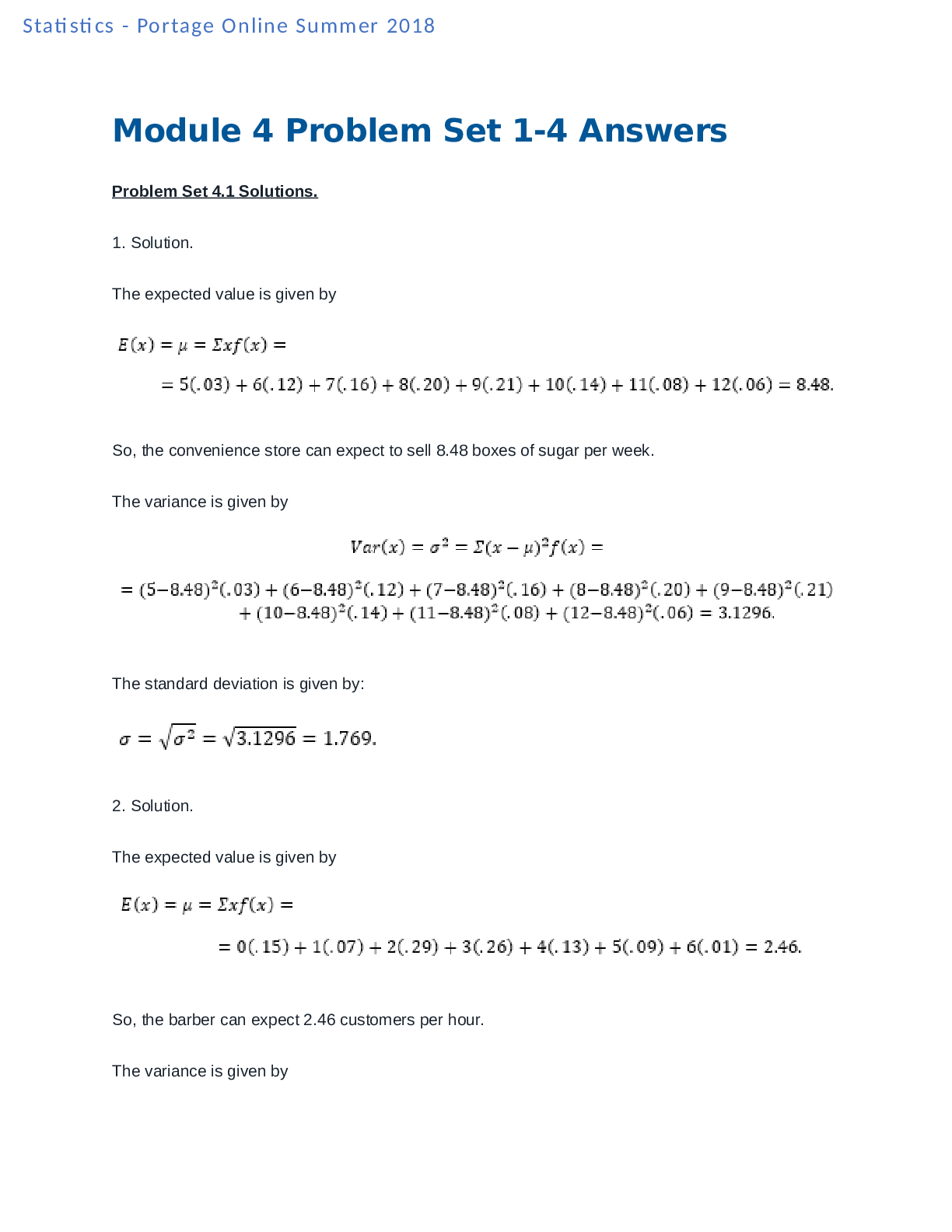
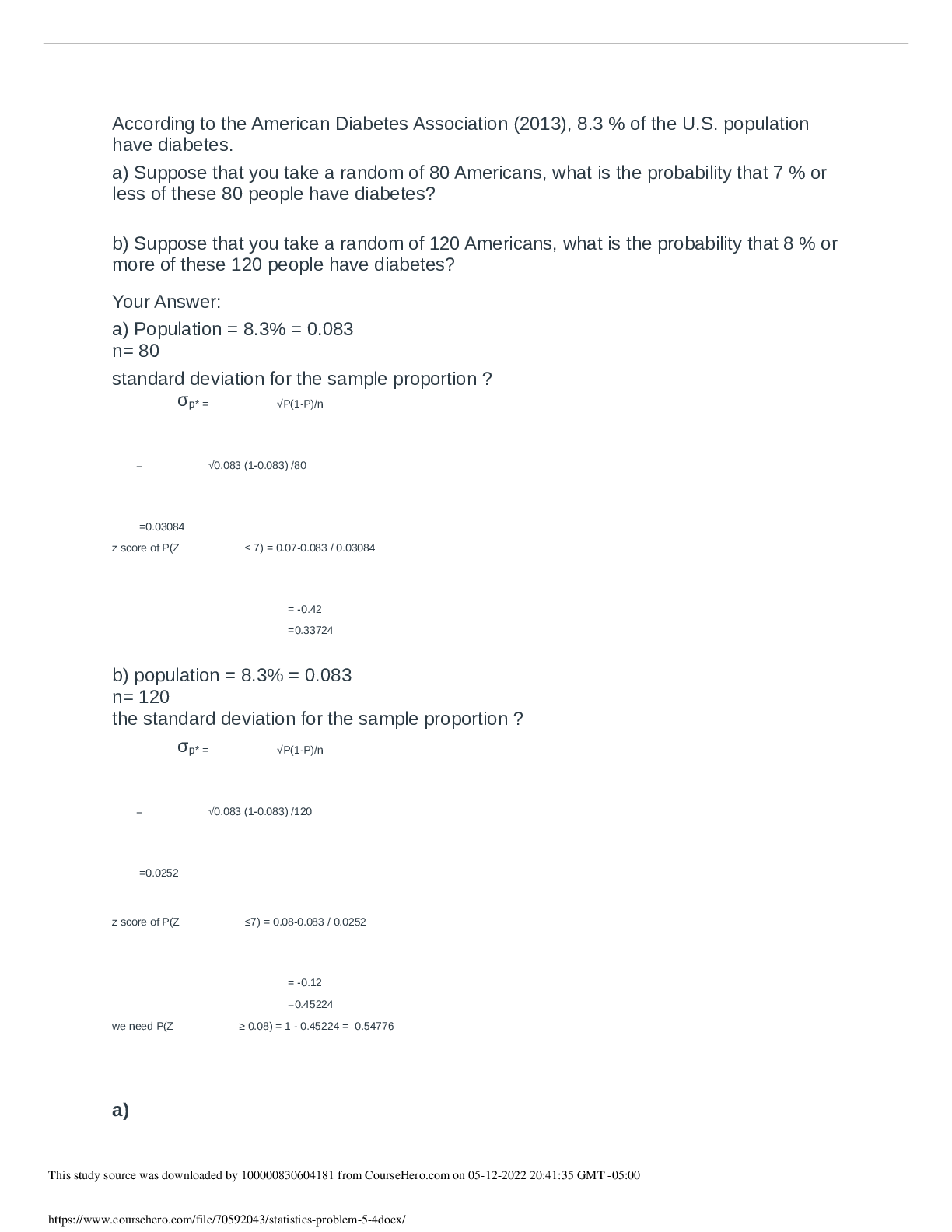
.png)
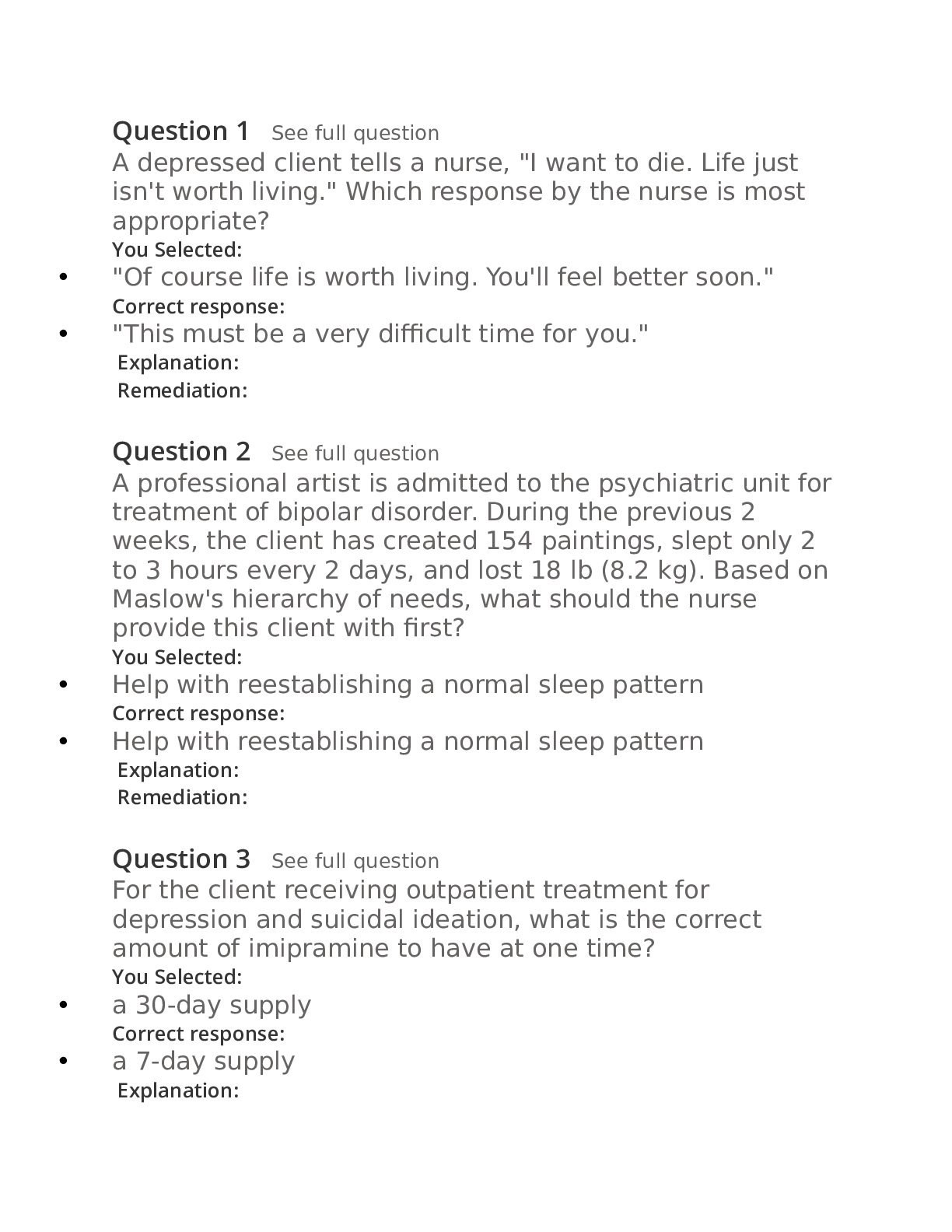
.png)
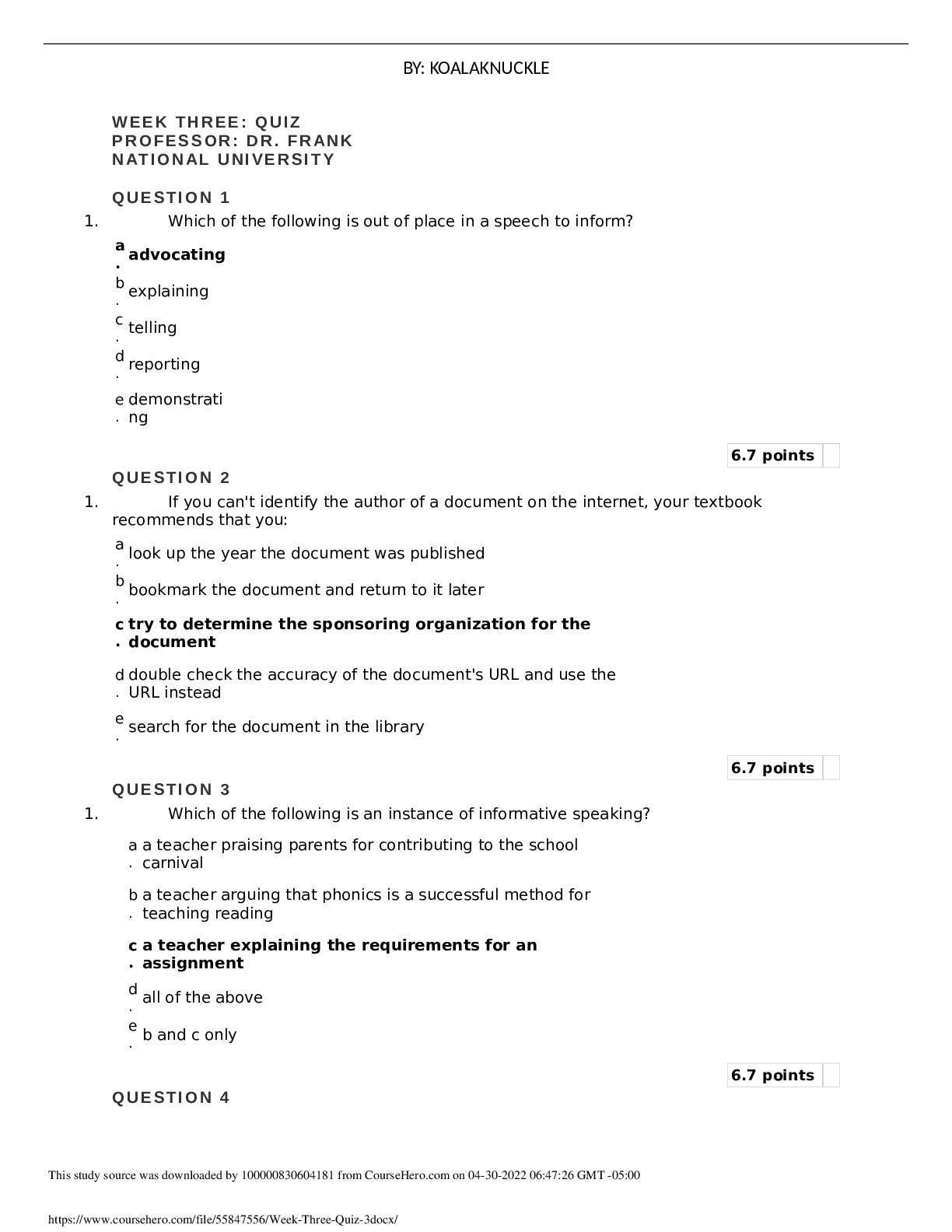
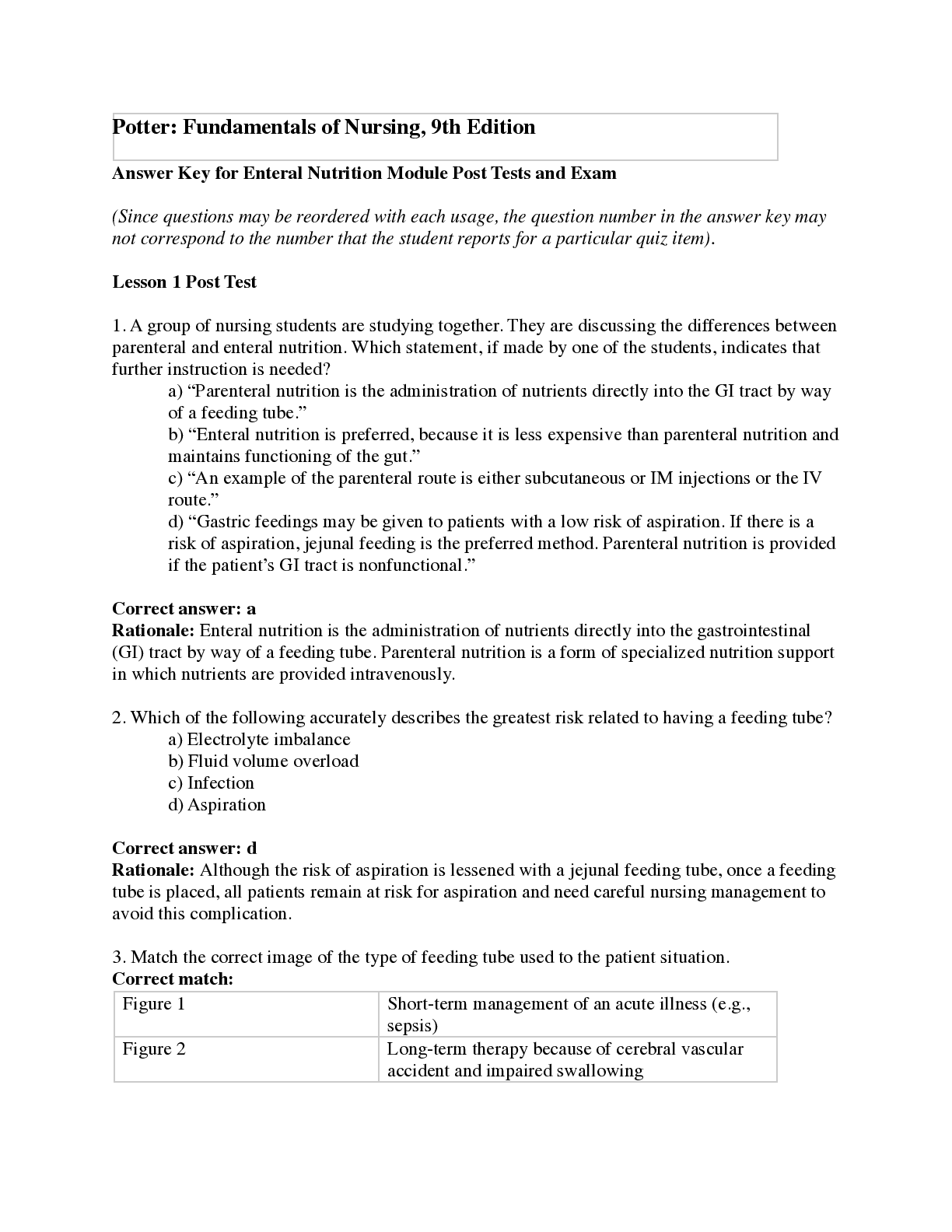
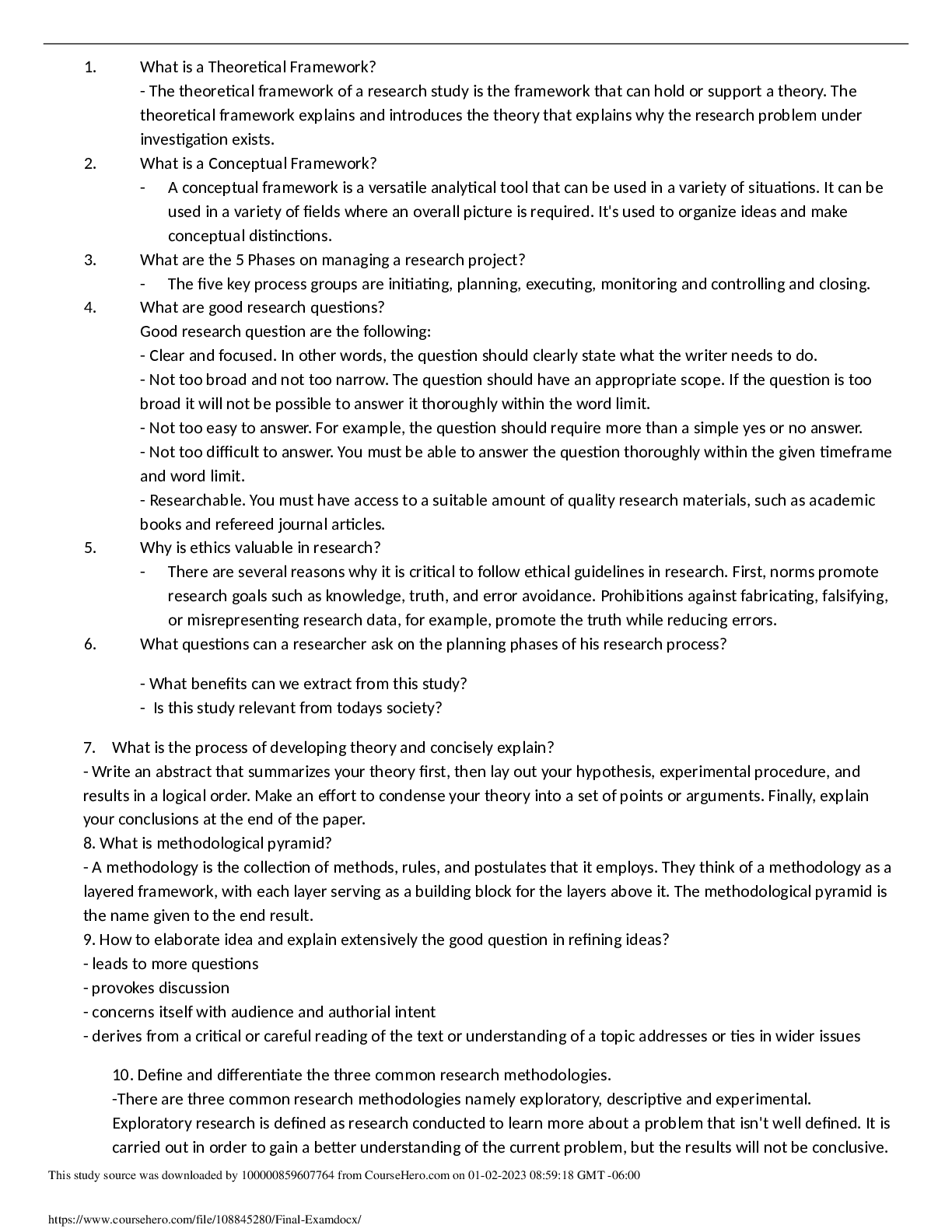
.png)

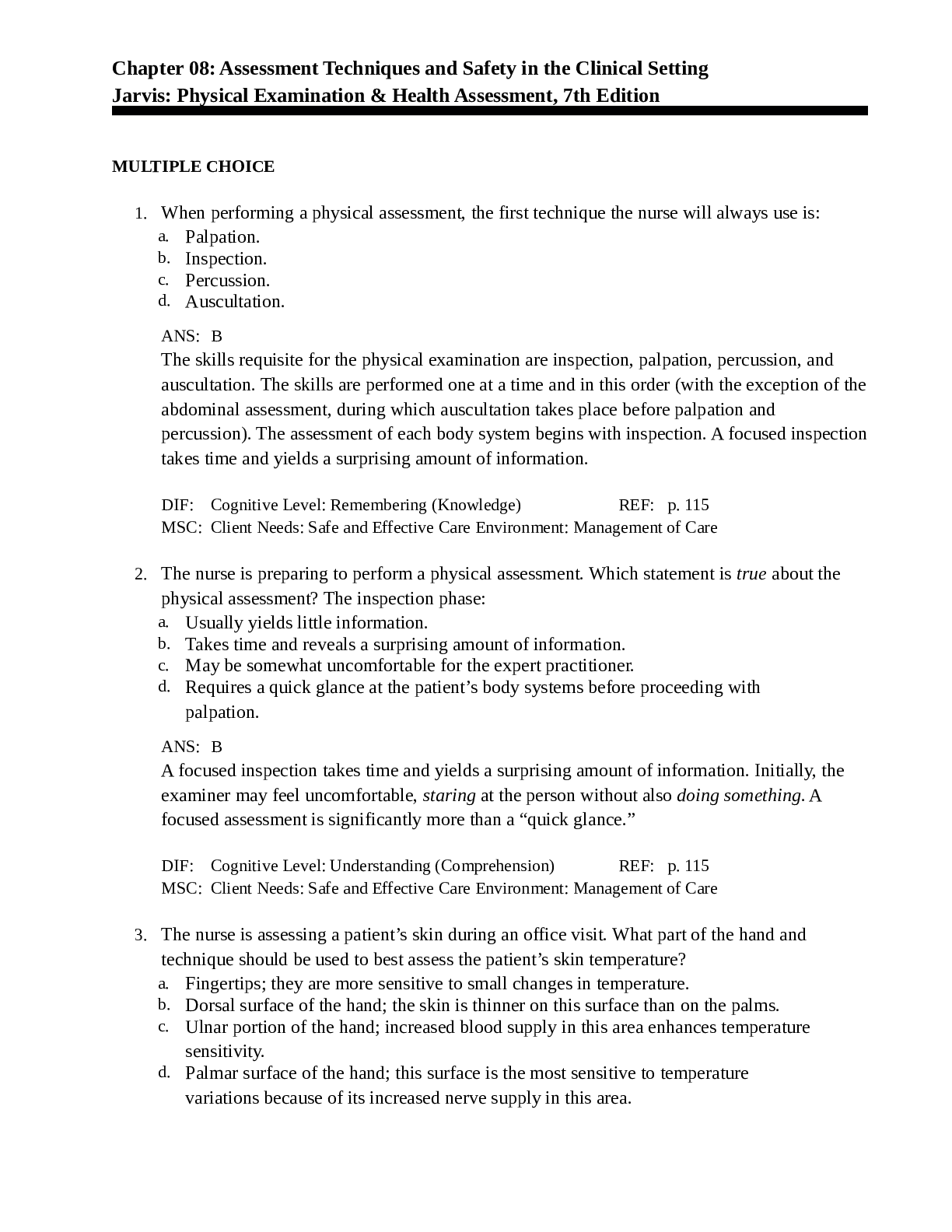
.png)


